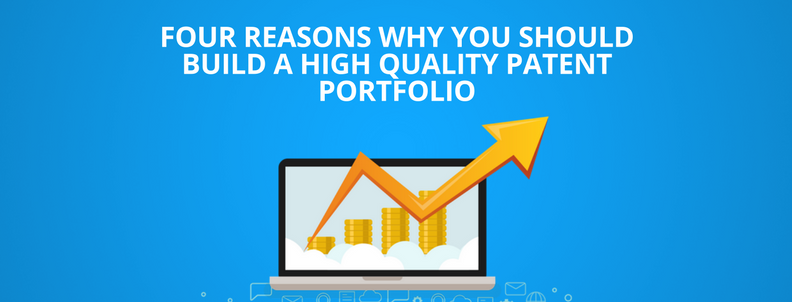NuCurrent Inc., a Chicago-based wireless charging equipment manufacturer earns millions in patent licensing every year, its licensees including the likes of Apple and Motorola. Did I mention they merely have 29 granted patents in their portfolio?
That’s the power of a strong patent portfolio. NuCurrent is not alone. There are multiple companies that make millions – and at times even billions – merely in licensing revenue. ARM Holdings, which makes all its revenue by licensing its IP, reportedly made $1.53 Billion in 2015 alone.
Patent portfolios, filled with high-value patents do not just open a new stream of revenue but also help organizations emerge as market leaders. One example is IBM, which is known for its innovation and has emerged as a market leader in several domains. Its rigorous patenting practice coupled with innovation has given the company an edge over others over the years. It’s patent portfolio, in addition to protecting the company’s innovations, brought billions in revenue for IBM till date, $1.19 Billion in 2017 alone.
One thing is clear from the three examples above — Licensing revenue or litigation doesn’t depend on the number of patents in a portfolio, as the number varies hugely for these three companies. In fact, what they have in common is the quality of the portfolio. High quality.
The advantages of having a high-quality patent portfolio are multifold. Below we have listed four of the major advantages that would convince you why it is paramount to build a strong portfolio for your organization. Let’s have a look.
Benefits of Strong Patent Portfolio
Quality Coverage
You might be thinking this is an obvious point. Patents are sought to protect the core inventions of an organization, what difference would a high-quality patent portfolio make? A strong patent portfolio is crafted in a manner that safeguards the entire product line by patenting all the features and any improvements made to a product by means of strong claims and divisional patenting respectively.
Claims of a patent are covered in a manner that it gets difficult for anyone to get around a patent, which could prevent any entity to develop a substitute product during the lifetime of a patent.
For instance, consider the example of US Patent 7569273B2 titled Thermoplastic powder Material for appearance models from 3D patent systems. This patent describes a technique to develop 3D models which is very basic and thus can enable the patent owner to easily limit others from entering the domain during the lifetime of the patent.
Though it is often debated that having such broad patents stifles innovation, if a company chooses to have such patents for defensive purposes, there’s no harm in it for anyone. Also, broad claims in patents help increasing monetization potential by increasing its scope.
Editor’s Recommendation: In his popular article, Shikhar suggests methods for filing broad yet high-quality patents. You can read it here — How to file good quality broad patents?
Some people, however, are of the belief that if you use broad patents, there is no difference between the organization and an NPE.
But if the focus is essential to protect the core products of an organization, no matter how the patent is used, the patent holder has a (legal) right given by the government to exclude anyone from making, copying or selling the patented technology unless a licensing deal is signed between the assignee and the infringing entity.
Survive Litigation
Litigation is an important aspect of the lifecycle of a patent where the patent has to stand the tests of invalidity and novelty for the plaintiff to emerge as a winner. It gets very easy for a defendant to find some solid prior art after a deep analysis for a low-quality patent.
For instance, in Apple vs. Samsung patent lawsuit, when Samsung appealed to the court to invalidate the Slide to unlock patent on the basis of obviousness, after examination of the prior art documents, the court invalidated the Slide to Unlock patent reducing 120 million dollars that Samsung had to pay for infringing Apple’s patents. Do you think it would have been possible if the patent was of high quality?
If the patents are not strong enough, it gets difficult for the plaintiff to continue protecting its technology despite having a patent over it. Which gets us to our second benefit — A strong patent portfolio helps survive litigation.
You see, better safe than sorry!
Technology Negotiations
Patents come with an expiry date, businesses do not.
But there are unfortunate times when a particular business isn’t profitable anymore and the company has the option either to cease operations or sell off one of its divisions to continue operations. In such cases, other than the direct revenues from the product line, the value of the intangible assets like the patent portfolio is calculated as well to decide the negotiating amount.
The benefit of having a strong patent portfolio in such situations is that even if a particular division is shut down; the intellectual property for the technology could still be used to extract maximum value.
For instance, when Nortel Networks, a telecommunication and data networking equipment company, filed for bankruptcy in 2009, the patent portfolio of the company was auctioned to regain some of the costs to pay off debts. With 6000+ highly valuable patents, their patent portfolio was bought by the Rockstar consortium for a whopping 4.5 billion dollars.
In order to defend its operating system Android, Google took a drastic step and acquired Motorola Mobility for colossal $12.5 billion. With 17000 patents in the portfolio, Google bought a shield that could protect it during the patent war. In October of 2014, after retaining the patent portfolio of Motorola Mobility, Google sold it to Lenovo for $2.91 billion. It is clear that Google purchased Motorola to acquire its patent portfolio.
The point is no matter what the circumstances are — a strong patent portfolio would always be helpful during negotiations. It does not just protect the products but also increases the overall worth of the company.
Improved ROI
Being a solid believer in ROI, I often prefer things that have a high return on investment. Through the example of NuCurrent and IBM, we have explored two companies whose patent portfolio yielded them a high return on investment by means of licensing opportunities.
A solid portfolio can improve the return on investments on patenting and R&D efforts by improving licensing opportunities since everyone wanting to work in technology has to acquire licenses over the major patents in a particular technology. And designing a high-quality patent portfolio often comprises of inculcating such star patents in one‘s portfolio.
Now that we have given you four awesome reasons to build a strong patent portfolio, go ahead and craft the changes accordingly. But only building a quality patent portfolio is enough? No! You should know how to monetize these patents. To help you in that pursuit, I have a free guide with 4 strategies that can help you monetize your patents without spending a single dollar on consultancy fees. You can download your guide here: click here to download
May you succeed in your endeavors!
Next Step: Explore more Patent Commercialization Strategies and create your own smart patent commercialization strategy using these tactics.
Authored By: Anjali Chopra, Sr. Analyst, Market Research.









